The Complete Norse Saga
On the 160 Vertical page I introduced you to the issues I faced getting on 160 meters with my small suburban lot. This page presents the story of how I successfully set up a vertical antenna on the Gentleman's Band.
It began in 2011 when my then co-worker Woody, WW1WW (tired of hearing me whine about my station's poor 160 performance) suggested converting my 100-foot dipole into a vertical by twisting the leads of the twin-lead together and feeding them into a balun. Radials, essential for a establishing a RF current return path to ground, would need to be installed. There were three challenges: 1. The small footprint of my property. 2. My house sits only ten feet from one side of my lot. 3. The only tall trees were also along the back end of the lot. So laying out radials would require some creativity. I began with four long radials at ground level:
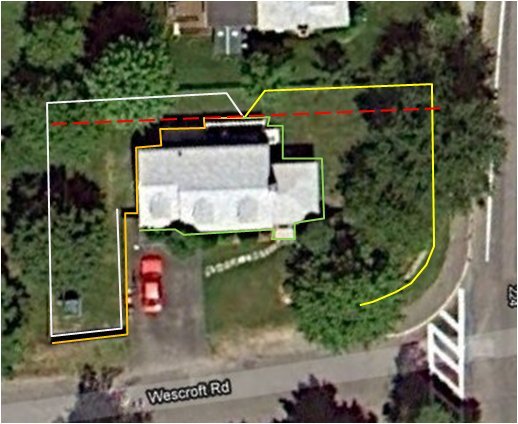
Aerial view of
the QTH showing the four radials(white, orange, yellow,
and green lines) and the location of the former dipole
(dotted red line) now acting as capacitive "top hat"
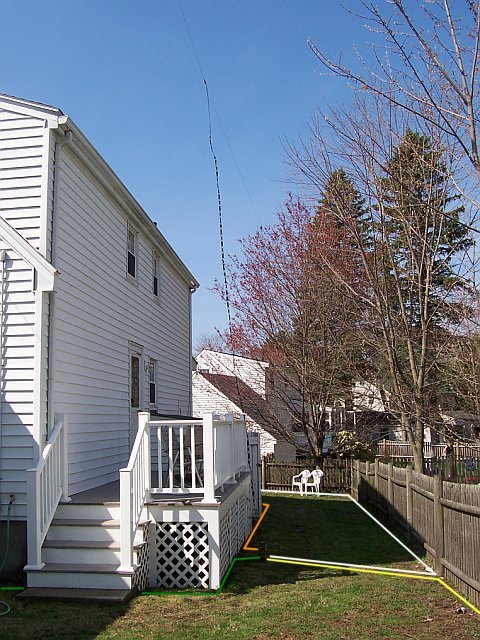
View of the former dipole, now a vertical, showing
locations of the four original ground-based radials
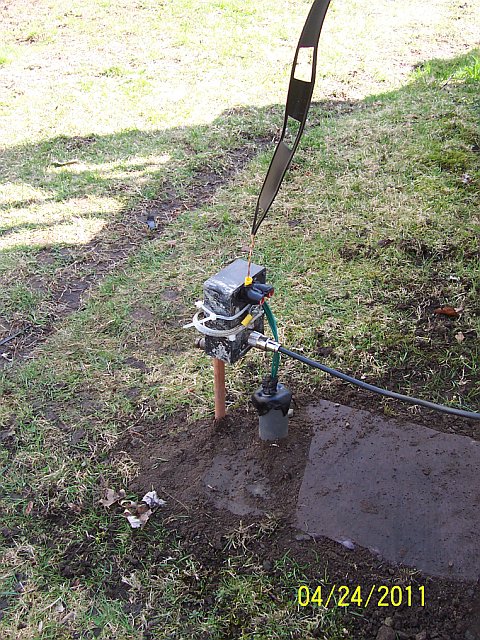
The MFJ Balun secured - and grounded - to a ground rod.
RG-8x coax feeds into the shack
and the MFJ tuner.
So how did it work?
Not well at all. Even with the MFJ tuner a decent SWR was
impossible:
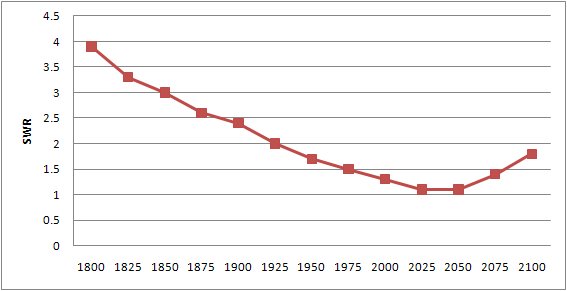
Plot of 160 meters adjusting the MFJ tuner for best
SWR every 25 kHz
38 special
To tune up a vertical only 25 feet high on
160 was going to require a loading coil. Using EZNEC
Woody modeled the antenna and calculated parameters for a
base-loaded coil; 38 turns of 10-gauge wire coiled 2" to
electrically extend the antenna. It would also eliminate the
need for the balun. I constructed a coil using a short piece
of PVC. A hole was drilled at one end for a binding post
with banana jack (I was seeking an easy way to attach the
radials.) An SO-239 was also installed.
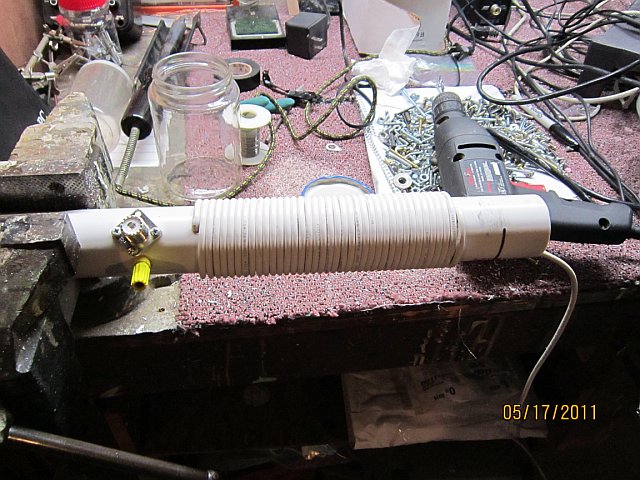
The coil is connected to the center of the SO-239 on the
inside of the tube

It exits from the top of the pipe through a plastic
cap. The cap and all holes were originally sealed
using my wife's hot glue gun (a QST "Hints and Kinks")
but, frankly, the glue did not provide a waterproof or
lasting seal, so had to redo with caulk.
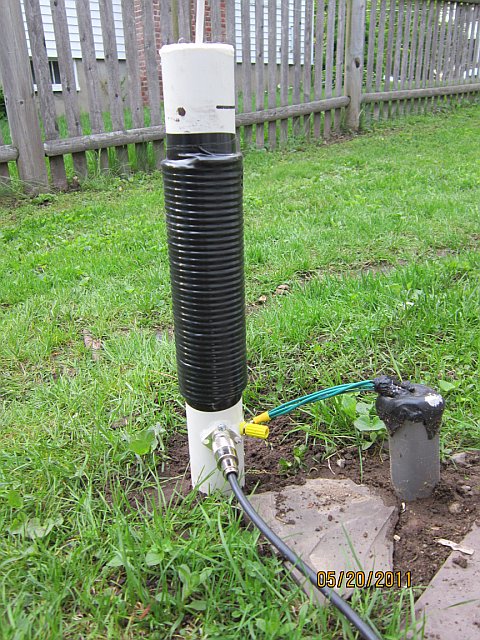
The new
coil, installed, with black tape wrapped around the
10ag wire.
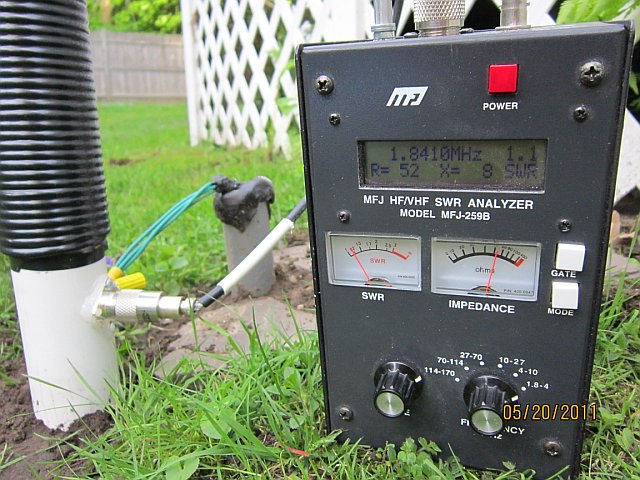
Readings
were taken with an MFJ-259B loaned by Erik, KE1V
(thanks!)
Before we look at the results... a brief
review.
| SWR |
X |
R |
| This is the ratio of the antenna impedance (Z) to the transmission line characteristic impedance (50 Ω). (My buddy Doug, K1DG, says it's basically a measure of how happy the transmitter is.) | This is reactance, the opposition to alternating current due to a combination of capacitance and/or inductance (present in every antenna.) An antenna is resonant when capacitance and inductance cancel each other out. | This is radiation
resistance, which measures the loss from the system
(antenna, conductors, radial system). In this case, it
is a reliable measure of how well the radials are
performing as a counterpoise - an RF path to ground. |
With four radials here are the plots of SWR, Resistance (R), and Reactance (X) across 160:
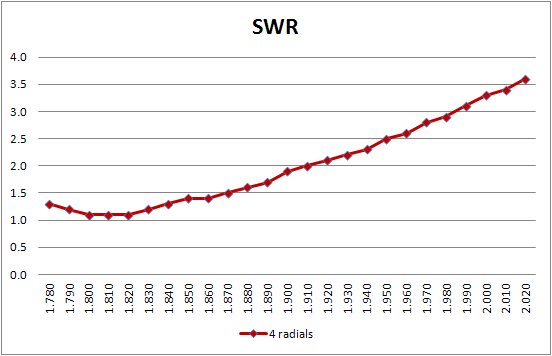
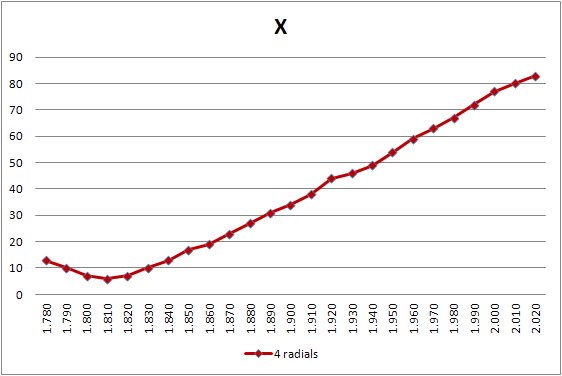
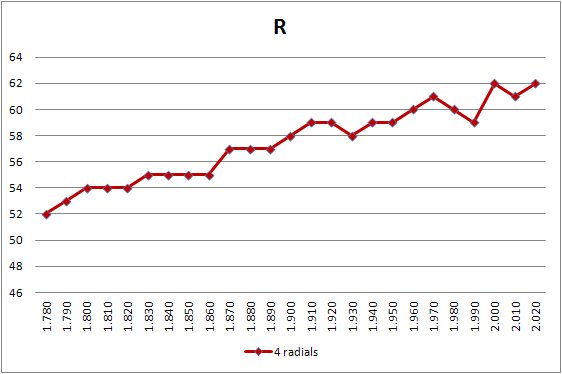
SWR and X were very good but R was over 50
ohms across the entire band. The four radials were a poor
counterpoise and performance would suffer. More
radials were clearly going to be needed, but you've seen the
size of my property. Where could I lay them?
Nurse... elevate me
The answer was found in the work done by
Rudy, N6LF in several QEX
articles
on verticals and radials which detail how elevated
radials can be as effective - and sometime more effective,
than ground-based radials. I ran a pair of radials
approximately 3 1/2" off the ground, along the upper support
of my fence:
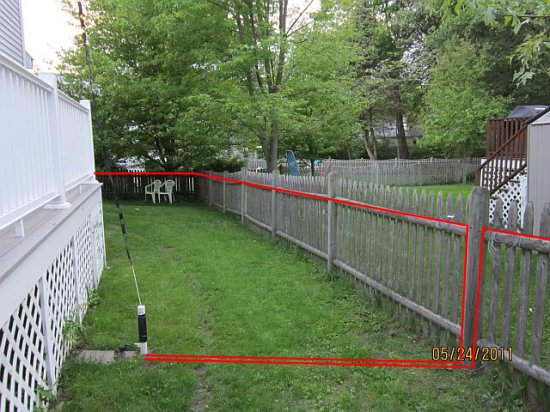
The red lines show where
the first two elevated radials being tested are
attached to the fence
This annotated aerial shows where I hung the elevated radials around the property:
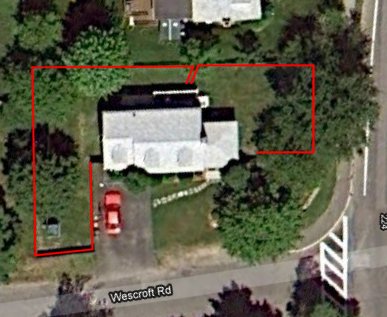
The length of the longer radial is a bit
less than 130 feet, or 1/4 wavelength at 160 meters.
Check out the plots for SWR, R, and X, which include the original four radials (shown in red) and the addition of two elevated radials (shown in blue). NOTE THE MFJ ANTENNA TUNER WAS NOT IN CIRCUIT. The SWR rose a bit but was still under 1.5:1 at the target frequency of 1.840 MHz. X was lower at the target frequency. What's most important is that R dropped almost 20 ohms across the band. An unqualified success!
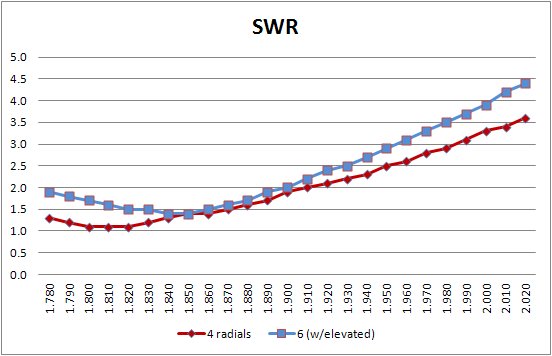
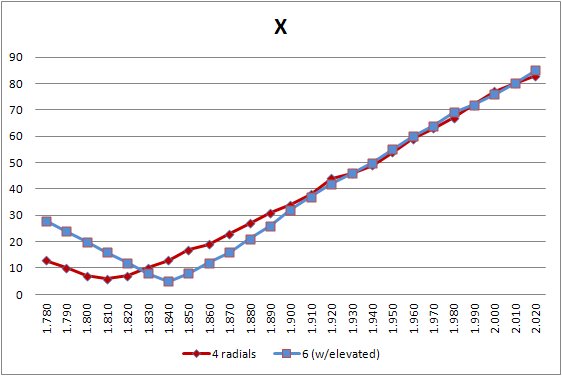
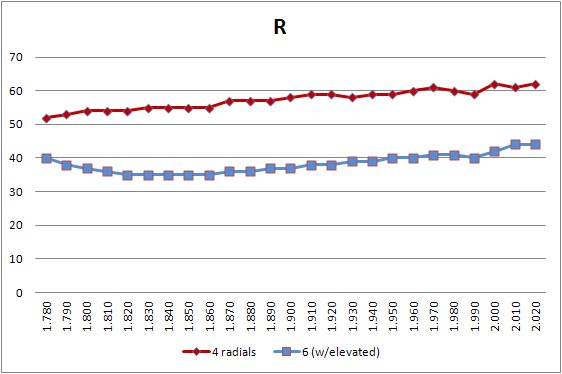
Some other interesting things happen with the
addition of the 2 elevated radials, like a steeper bend in
the plot of X (an increase in Q.) But wow look
at R - as much as a 20+ ohm difference from the 4-radial
configuration. Outstanding. But can we do better?
8 is Enough?
Over the next month I experimented with
several layouts of radials, including two on the top of the
fence and another test with a "spider" of eight 16' radials
(testing the theory that more radials, even short ones, will
improve antenna performance.) None lowered R. In fact
(and I challenge you to do the math - because I can't) both
tests actually raised R across the entire band! In
late August, 2011 I decided to try a couple of longer,
ground-level radials:
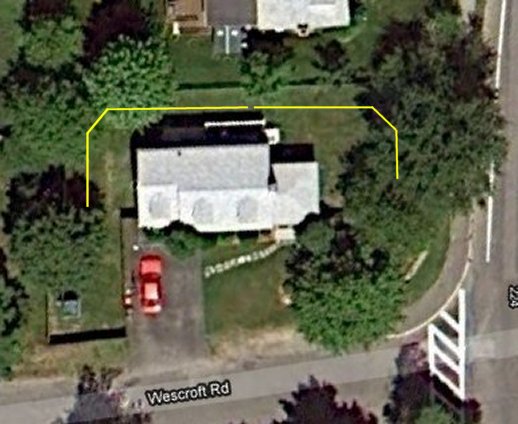
Location
of the additional 2 radials
The results, plotted
in green below, show a slightly higher SWR
with X not changing appreciably from the levels measured
with 4 (red) or 6 (blue) radials. But
there was good news in the data as R shows the extra 2
radials reduced R across the entire 160 meter band by
another 5 ohms, as low as the 30 ohm range near the lower
part of the band, precisely in the targeted area of the band
(CW & FT8).
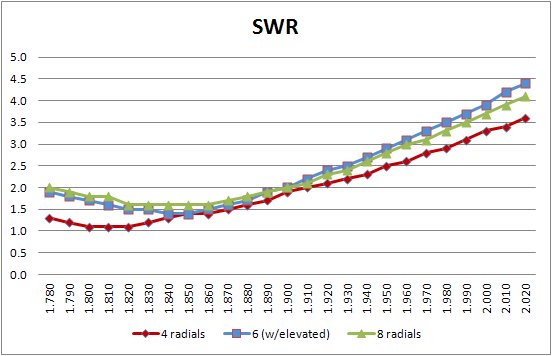
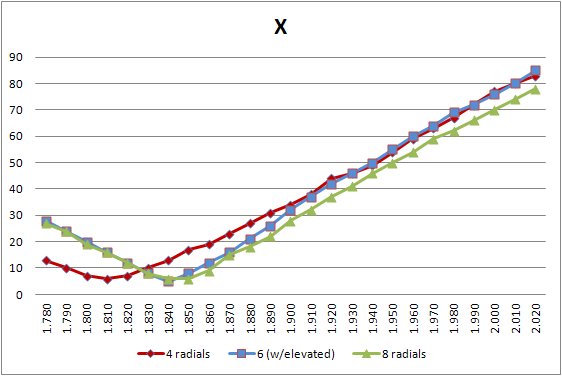
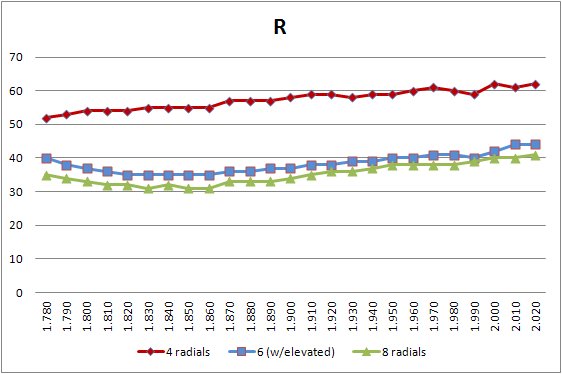
It appeared the point of diminishing returns
had been reach, with respect to the number and placement of
radials. By then it was winter 2011/12 the best time of year
for operating 160. During the next few months I contacted 41
states and 9 new countries, a HUGE improvement over the
dipole.
May 2012 Update
The vertical was great, but I missed the dipole and its performance on 80-10 meters. To allow both vertical and dipole operation I added a relay, mounted on top of the loading coil, so I could switch the antenna remotely, from the shack.
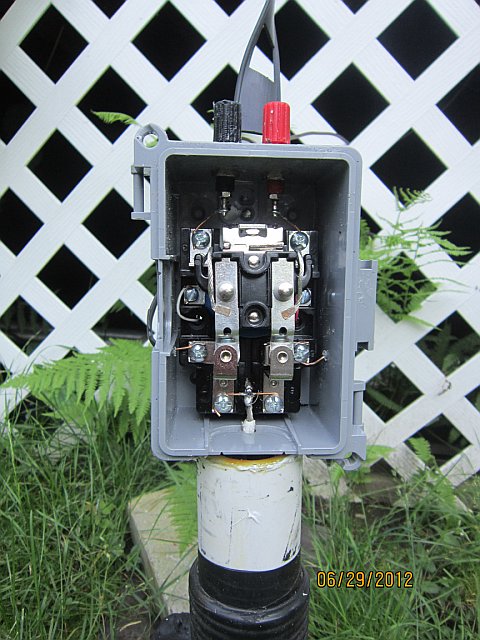
OMRON MGN2C-DC12 relay
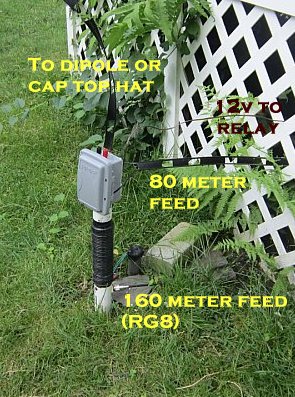
Annotated look at the feeds to the relay.
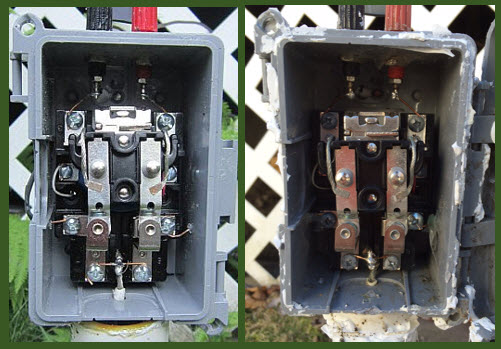
The result of three and a half years of New England weather on the relay
Those two solder joints to the jack up top were so loose it is amazing that the antenna worked at all in either 160 Vertical or dipole configuration.
I discovered another weak link in the antenna system: the banana jack I had "cleverly" installed in the PVC to easily connect and disconnect
September 2017
In 2017 I discovered that the tree in which I had hung one side of the 100' dipole had been girdled (that's when varmints nibble away the bark, preventing the tree from getting water and nutrients, effectively killing it) so I had the tree removed, and then installed this 40' aluminum mast from ChannelMaster, which held up the east side of the dipole/top cap for the 160 vertical.
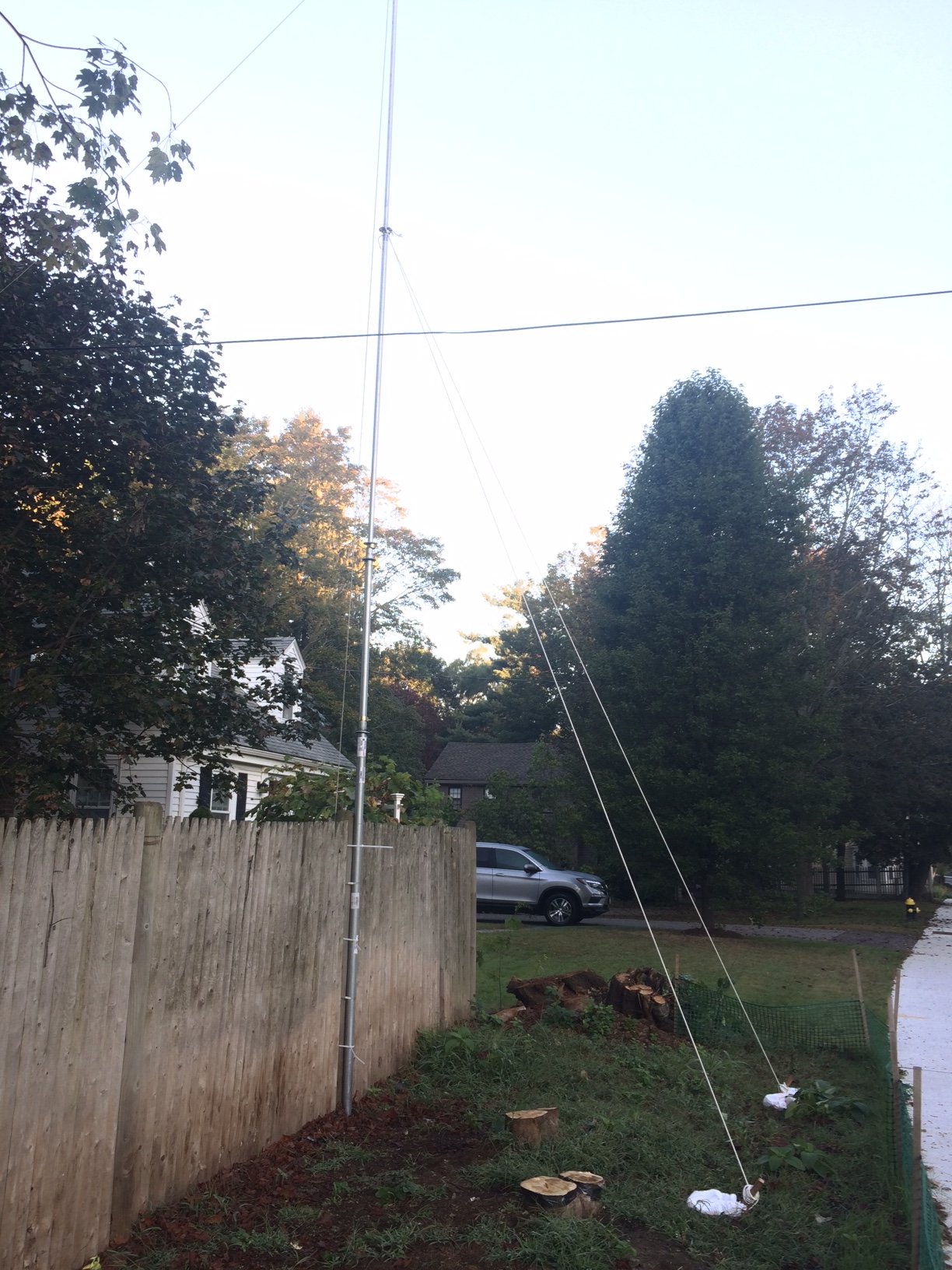
March 2018
The weather people are saying "March is the new February," and I can attest to the fury of a March 8th storm which started as rain and THEN turned to snow, which weighted down everything outside, including the 40' ChannelMaster mast which, when I woke up the next morning was bent beyond repair.
The next month, my new, very kind next-door neighbors gave me permission to hang one side of my dipole/vertical from a tree on their property. After a few flings of a one ounce fishing weight with my sling shot (purchased at a ham flea market) I was quickly back in business. Here's an annotated aerial of the property with the new alignment of the dipole/top cap (blue is a 20 meter dipole and green is my ten meter dipole):
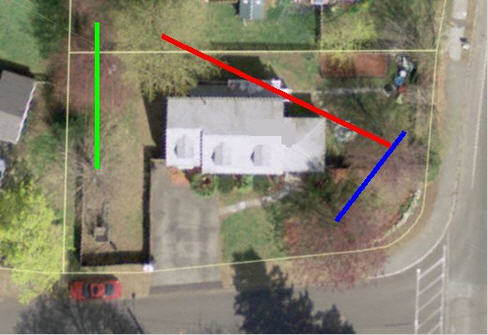
As luck with have it, the center of
the dipole ended up directly over the outdoor switch
box, which eliminated the need for me to move it and
all the support cabling and power line. Back on the
air with both long dipole and 160 vertical, and
picked up a few more long-distance countries
(Iceland and the Slovak Republic) on 160...
January 2019
Took advantage of what for passes for a warm January
day in a New England and took out my sling shot, a
5oz weight, some fishing line, and pulled.
Hard. Zowie! Got the antenna raised about 20'
higher.
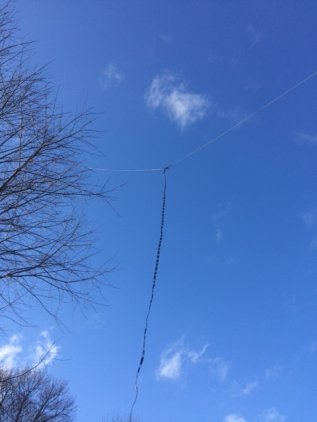
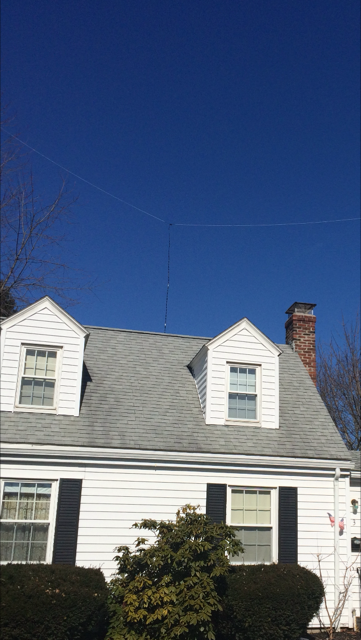
Two views of the antenna (l: back of the house, r:
from the front) now 16' higher...
Mine clearly was, because the morning after the second day of wind it was down, split right in the center at the connection between the twin lead and the dipole/top hat. Took out my trusty sling shot and found either the tree has grown that much taller or my arthritis has gotten that much worse. But now I had an excuse to try something new - using a drone to drape the fishing line over the tops of the two trees. It took a while to find a willing licensed pilot with a quick release device who was comfortable hoisting the fishing line + two ounce fishing weight over the trees. His name is Doug Pratt (click on his name to email him) and he performed two flawless flights on a recent, unseasonably warm February day north of Boston.
Doug (in the trench coat) is setting up his DJI Mavic 2 Zoom drone (just one of several he owns) for the job.
He attached (with Velcro) a remote-controlled quick release device
Click the image for YouTube video of the drone in flight
Looks like we achieved a height of between 55 - 60 feet for the 160 vertical.